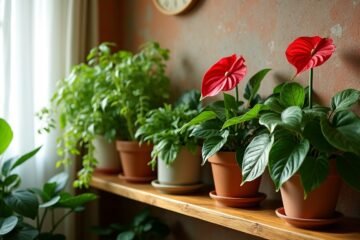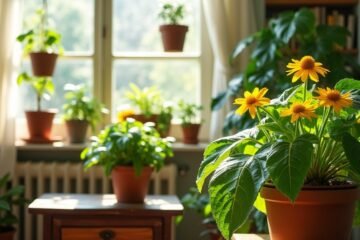Indoor gardening can feel like a jungle adventure, but watch out for those common mistakes! Overwatering can drown your plant pals, while ignoring their light needs can leave them stretching for help like a kid reaching for the last cookie. Using poor quality soil is like trying to build a house on quicksand—yikes! Make sure to feed them nutrients and keep an eye out for pesky pests. Curious about other traps to avoid? There’s more to explore!
Overwatering Plants

Overwatering plants can feel like a sneaky villain in your indoor garden—one moment, your greenery looks vibrant and happy, and the next, it’s drooping like it just heard bad news! It’s easy to drown them with love, but too much water leads to poor soil drainage, smothering those precious roots. Imagine your plant roots gasping for breath, trapped in a soggy prison! You might think, “Just a little more water won’t hurt, right?” Wrong! That’s a one-way ticket to root rot, where your plant’s lifeline literally rots away. Instead, check your soil moisture before watering. If it’s still damp, let your plants bask in the dryness a bit longer. Remember, happy plants thrive on balance!
Ignoring Light Requirements
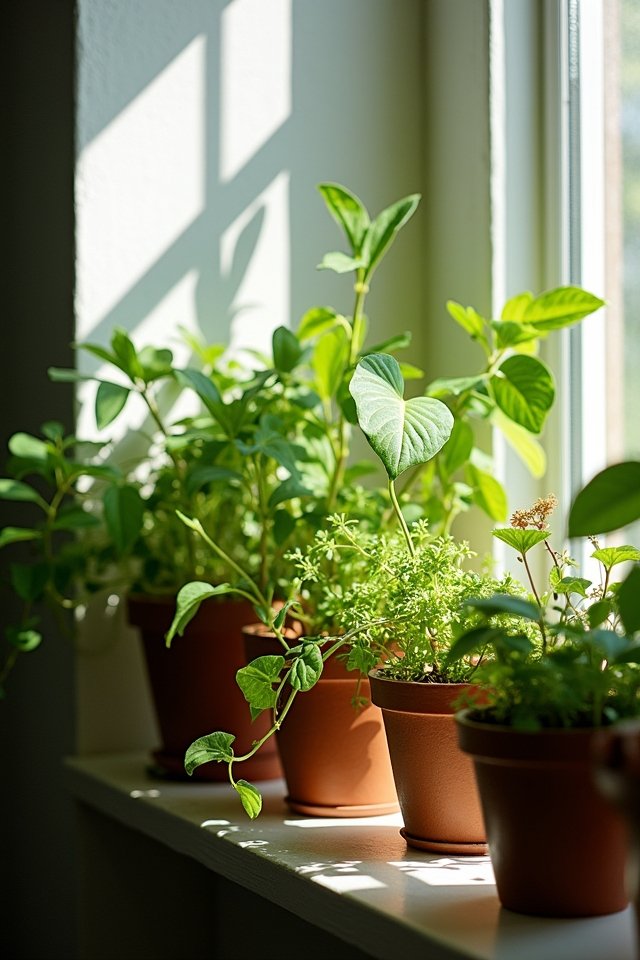
Light’s like nature’s spotlight for your indoor plants, and ignoring their unique light requirements can leave them feeling like wallflowers at a party! To thrive, every plant needs the right light intensity, whether it’s bright and direct or soft and indirect. Think of succulent varieties, craving that sun-filled corner, while your ferns will flourish in cozy, shaded nooks.
Don’t just shove every pot on your windowsill; experiment with plant placement! Move them around, observe their reactions. Leaves curling? Too much sun! Stretching tall? They’re crying for more light. Remember, it’s all about finding that sweet spot where your plants can dance in the light, rather than sulk in the shadows! So, give them the spotlight they deserve!
Using Poor Quality Soil
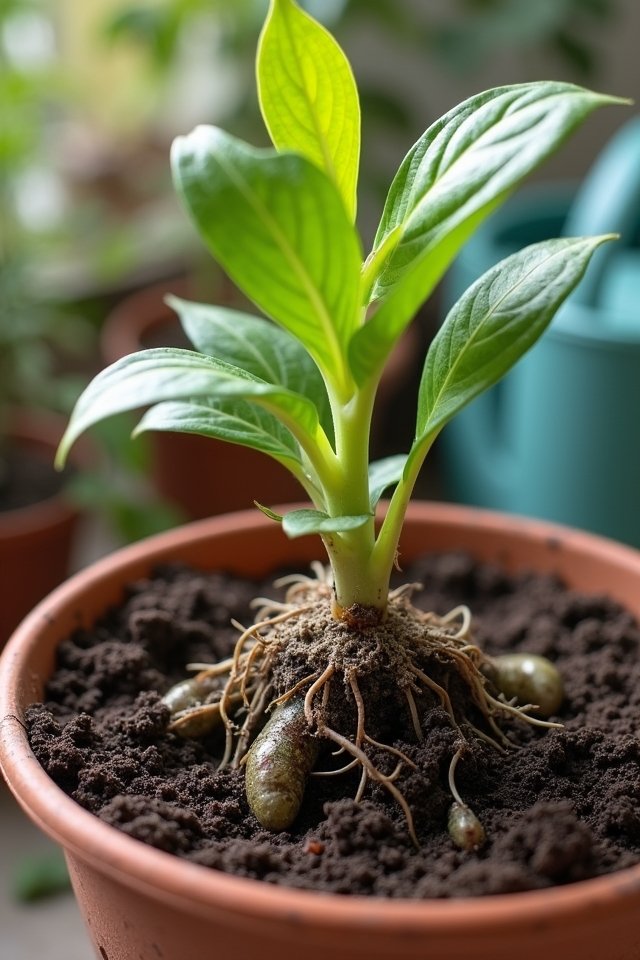
When it comes to indoor gardening, using poor quality soil can feel like trying to grow a concert piano with a rusty old kazoo! The right soil types are vital for your plants’ success. You wouldn’t want to set your lovely green companions up for failure, would you? Opt for premium mixes that include beneficial nutrients!
Here are three essential tips for getting the best soil:
- Choose the right soil types: Look for potting mixes designed specifically for indoor plants.
- Add soil amendments: Incorporate perlite or vermiculite to improve drainage and aeration.
- Test your soil’s pH: Verify it’s within the ideal range for your particular plants!
With quality soil, you’ll cultivate a thriving indoor jungle in no time!
Neglecting to Fertilize

Quality soil lays a strong foundation for your indoor garden, but don’t forget about feeding those green beauties! Without the right fertilizer types, your plants might feel starved, like a chef without spices. Think about it—just as we need balanced meals, your plants crave nutrients too!
Liquid fertilizers can be speedy boosters, while slow-release pellets offer a steady feast over time. Timing’s everything, so feed them during their growing phase—typically spring and summer. It’s like throwing a party just when your guests are ready to eat!
Don’t wait until they’re drooping and desperate for a meal. Nourishing your plants is the key to lush, vibrant life, making your indoor garden a glowing oasis. Why settle for less?
Skipping Pest Prevention
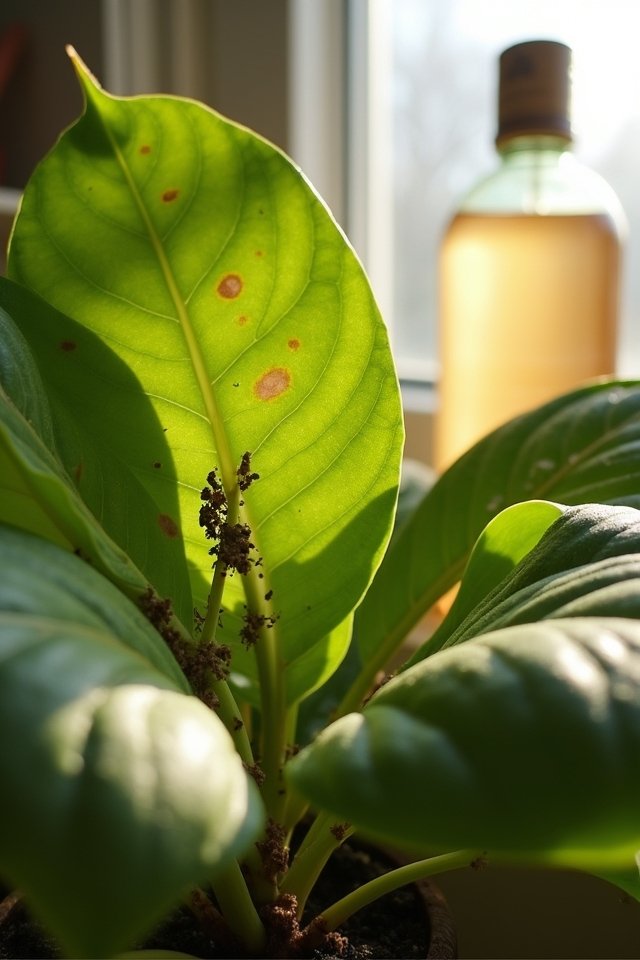
Pests can sneak into your indoor garden like uninvited guests at a party, ready to crash the fun! You might think you’re safe, but a few tiny critters can ruin your organic oasis. Neglecting pest prevention is a common pitfall, but here’s how to ward off those pesky intruders:
- Prioritize pest identification: Know your enemies! Regularly scan your plants for signs of infestations, like yellowing leaves or sticky residue.
- Implement organic solutions: Consider neem oil or insecticidal soap to tackle pests without harming your plants.
- Maintain cleanliness: Keep your garden tidy, removing dead leaves or debris that invite pests to settle in.
Stay proactive, and you’ll enjoy a flourishing indoor garden without unwanted squatters! Isn’t that a party you’d want?
Choosing Incompatible Plant Varieties
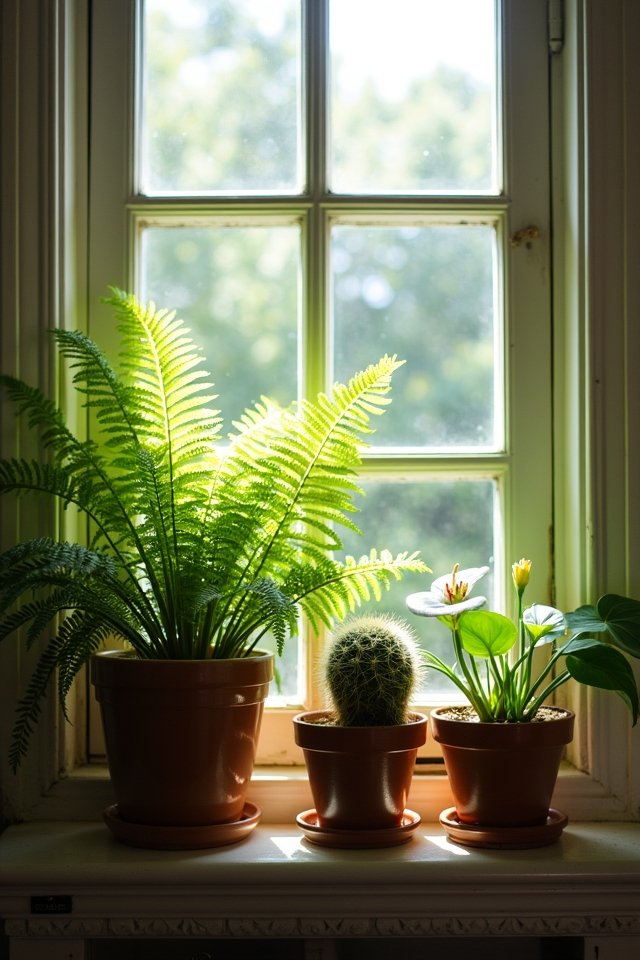
Even though you might dream of a lush, vibrant indoor garden, choosing incompatible plant varieties can turn that dream into a plant-parenting nightmare! Imagine your sun-loving succulents partying hard next to shade-loving ferns—yikes! Understanding plant compatibility is essential for variety selection. For instance, mixing herbs like basil and rosemary works wonders together, but adding a moisture-loving peace lily might spell disaster. They’ll compete for nutrients and attention, leaving you with wilted dreams. Instead, group plants with similar sunlight, water, and humidity needs. Picture a tropical oasis thriving with ferns, snake plants, and pothos, each reveling in their environment! Avoid the drama of incompatible combos, and create a colorful, harmonious indoor haven that will make your plant-parent heart sing!
Forgetting to Prune
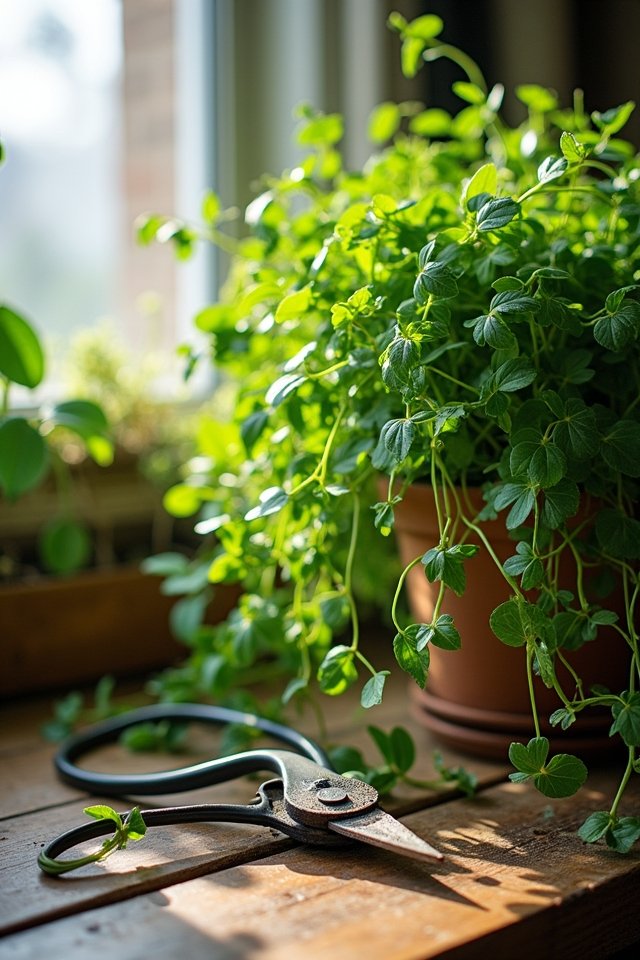
While it might seem tempting to let your indoor plants grow wild and free, forgetting to prune can lead to a jungle of chaos! Regular maintenance isn’t just about aesthetics—it’s the lifeblood of your plant’s health. Plus, using the right pruning techniques at the right timing is essential!
- Cut away dead or yellowing leaves to reveal fresh growth.
- Trim leggy stems to promote bushier, fuller plants.
- Remove any overcrowded branches to allow light to reach every nook and cranny.
When you prune effectively, your plant can thrive and flourish! So, don’t be afraid to wield those scissors. Just think of pruning as a stylish haircut—your plants will love you for it! Will you step up your game?
Improper Pot Sizes
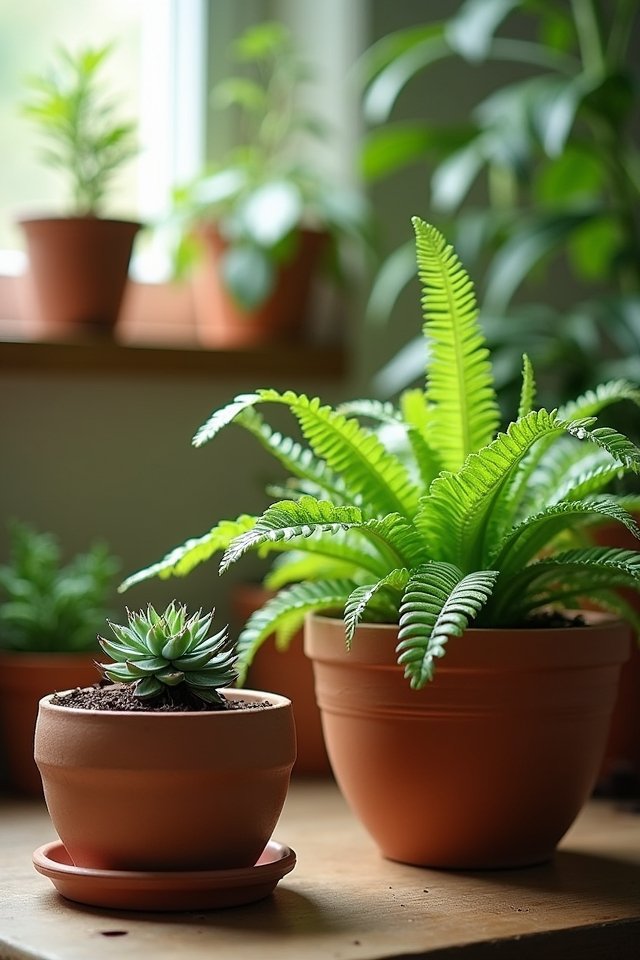
Choosing the right pot size is like finding the perfect outfit for your plant—too tight, and it’s squished; too loose, and it’s swimming in a sea of soil! You’ve got to take into account pot depth as well. A deep pot’s great for plants with long roots, while a shallow one suits those with a shorter stature. And don’t forget drainage holes! Without them, your plant could drown in overwatering. Imagine your poor plant’s roots gasping for air! Envision this: a luscious peace lily thriving in a snug pot, yet not too cramped. It’s like a cozy hug—perfect! So next time you shop for pots, think of your plant’s needs, and make sure it feels both stylish and comfy! Happy planting!
Lack of Humidity Control
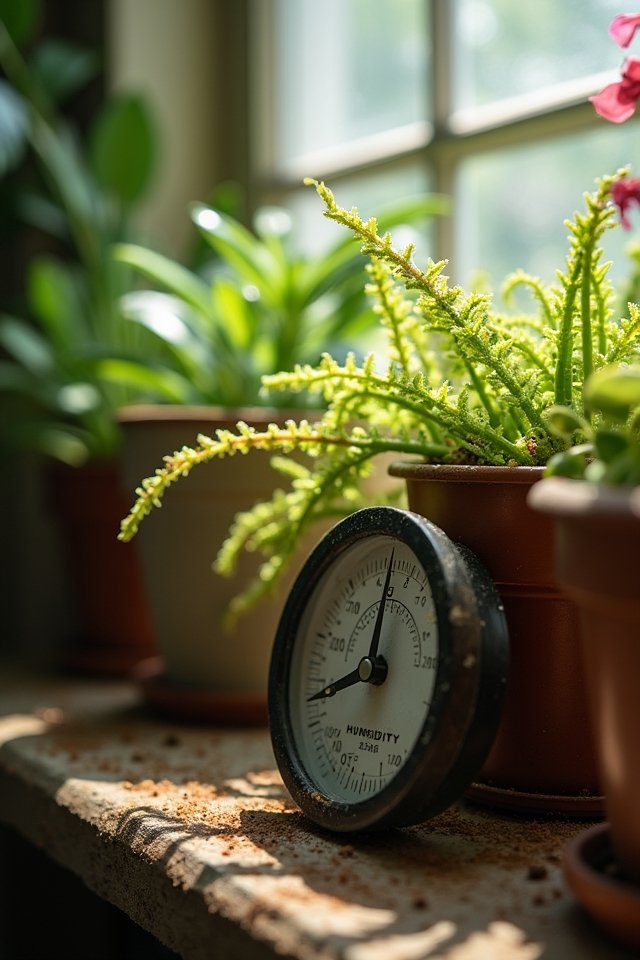
Did you know that most houseplants actually thrive in humidity levels of 40% to 60%? If you’re not controlling humidity, you’re missing out on a lush, green paradise! Low humidity can leave your plants feeling like they’re sunbathing in the Sahara. Here are some effective humidity sources to evaluate:
- Humidity trays: Fill a shallow dish with pebbles and water, placing your plant pots on top.
- Misting: A quick burst of water using a spray bottle can mimic soft summer rain.
- Humidifiers: These devices add moisture to the air, making your indoor oasis feel like a rainforest!
Frequently Asked Questions
How Often Should I Check My Plants for Pests?
You should check your plants for pests at least once a week! Think of it as giving your green friends a little health check-up. Look closely for signs like webbing or tiny bites. Regular pest identification helps you spot trouble before it spreads. Prevention’s key—clean leaves and good airflow are your pals! If you see a bug, don’t panic! Sometimes they’re just party crashers, ready to go home. Keep your plants happy and thriving!
Can I Use Tap Water for My Indoor Plants?
Absolutely, you can use tap water for your indoor plants, but watch that water quality! Some folks’ tap water is like a smoothie for plants—full of goodies! But if it’s chlorinated or loaded with minerals, your greens might not thrive like you hope. Consider letting it sit overnight so the nasties evaporate. Just remember, happy plants sing! Water them right and you’ll be rewarded with lush growth and vibrant beauty!
What Tools Do I Need for Indoor Gardening?
Ready to dig into indoor gardening? It’s as exciting as unwrapping a gift! To get started, grab essential gardening tools like a sturdy trowel and a trusty watering can. Don’t forget indoor gardening supplies like potting soil, seed trays, and sharp scissors for snipping leaves. With these buddies by your side, you’ll nurture thriving greenery in no time! Who knew a little dirt could bring such joy? Let’s get growing!
How Can I Tell if My Plant Needs More Light?
If your plant looks like it’s plotting to escape, it might need more light! Look for light indicators—like leggy stems or yellowing leaves. If your plant’s reaching toward the window like it’s desperate for a sunbath, that’s your sign! Consider moving it closer to a bright spot, or try grow lights. Remember, they thrive on light like you thrive on coffee! Don’t let your green buddy flop; give it a chance to shine!
Are There Specific Plants That Are Easier for Beginners?
Imagine stepping into a living fairy tale, where even the smallest seeds sprout into joy! For beginners, easy-to-grow herbs like basil and mint can fill your kitchen with freshness, while delightful, beginner-friendly succulents like jade plants or aloe thrive on limited care. They’re like the loyal sidekicks of your garden! Want some color? Consider vibrant pothos or snake plants! They’ll make your space sparkle while you bask in your gardening triumphs!
